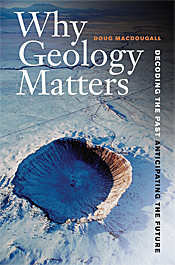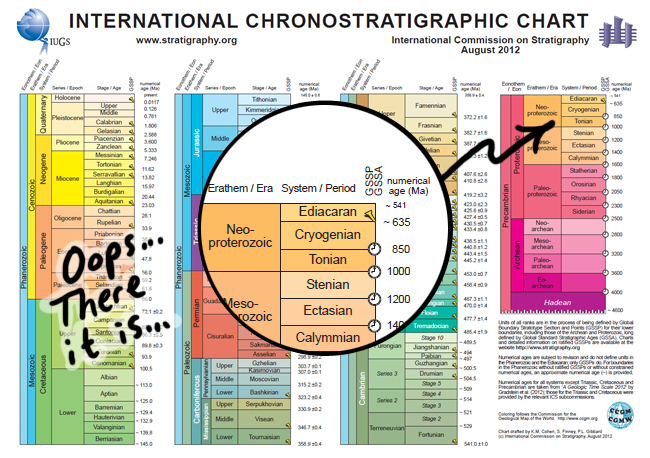 A couple of weeks ago, I snuck into campus on a Saturday. It was my first time there since Baxter was born, which means that I had two months of mail waiting for me. There were some nice treats in there, including several review copies of new books. I finished one of them last week, in the middle of the night, after a Baxter-induced but sinus-infection-exacerbated bout of insomnia. It was called Why Geology Matters: Decoding the Past; Anticipating the Future, by Doug Macdougall.
A couple of weeks ago, I snuck into campus on a Saturday. It was my first time there since Baxter was born, which means that I had two months of mail waiting for me. There were some nice treats in there, including several review copies of new books. I finished one of them last week, in the middle of the night, after a Baxter-induced but sinus-infection-exacerbated bout of insomnia. It was called Why Geology Matters: Decoding the Past; Anticipating the Future, by Doug Macdougall.
It aims to be a general interest geology book, and I think it succeeds quite well at that task. Reading it was a very similar experience to the excellent Reading the Rocks by Marcia Bjornerud. For my money, Bjornerud’s book is the better of the two – because it’s more lyrical, and because it is really big picture stuff, explored via its details. (I loved its essay relating crystal defects to the height of mountain ranges, and its exploration of how extinct isotopes of aluminum reveal the early solar system followed extremely quickly on the heels of the Sun’s recently-supernovaed previous iteration.) I feel like she wrote her book as a paen to geology’s epic scope. In contrast, Macdougall writes as a geologist trying to spread the good word to non-geologists. I opened it hoping to having my mind blown anew, but most of what he covers is material that I cover with my own students, and so while I think Why Geology Matters is an important contribution to the world library, it’s not necessarily delectable to a professional geoscientist in the same way that Reading the Rocks is.
That being said, I did pick up a few new tidbits – for instance, that there is a period of enhanced bombardment by meteorites documented between 500 and 450 million years ago. I liked his analogy of the Hawaiian islands being like “someone sending smoke signals from a campfire; each puff of smoke rises above the fire and is carried away on the breeze until there is a long, horizontal chain of discrete blobs of smoke in the sky.” (That comes close to the geopoetic sensibility of Marcia Bjornerud!)
I appreciated the emphasis he put on Snowball Earth (something I know a bit about) and the PETM (Paleocene-Eocene Thermal Maximum; something I don’t know enough about) as major perturbations to the Earth-ocean-atmosphere energy exchange system. I learned that perhaps there was even a Lake Nyos-like explusion of methane in a marine basin between Greenland and Norway (when the Atlantic Ocean was smaller), that may have kick-started the PETM warming.
I also appreciated Macdougall’s shining a spotlight on Large Igneous Provinces (LIPs) as a major “everyone should know this” theme in geology. He points out the correlation in timing between the eruption of LIPs and mass extinction events – the well known examples of Siberian (end-Permian), Deccan (end-Cretaceous), and one that’s just in my backyard, and associated with the runt of the Big Five: CAMP (Central Atlantic Magmatic Province) and the end-Triassic extinction.
I noticed a few errors… At one point he emphasizes India breaking away from Australia (in the past), whereas every Gondwanan reconstruction I’ve seen shows that the bigger break would have been India from Africa, or Antarctica. True, the two continents are interpreted to have been adjacent in the past, but they were only “just kissing” as compared to the long marginal connections between India and several other blocks of continental crust.
Elsewhere, he states, “The Cryogenian is not an official period of the geological timescale, but the term is in widespread use among geoscientists.” The International Commission on Stratigraphy would beg to differ:
Of course, there’s more than one “official” geologic timescale, and perhaps Macdougall was referencing a different source than I am.
Lastly, I hereby quibble with an aspect of Figure 31, his “important events” summary timeline. He shows the Appalachian Mountains forming in three pulses (correct) but those three pulses are centered on the Silurian, the mid-Carboniferous, and the late-Permian-into-early-Triassic:

This is not where I would have put them – around here, it’s more like late Ordovician (Taconian Orogeny), late Devonian (Acadian Orogeny), and then Pennsylvanian-into-Permian (Alleghanian Orogeny). I wonder if this bar just got slid a little bit out of place?? It seems like an odd error to make. Then again, Macdougall hails from San Diego, and I know it’s easy to goof up the geologic history of places where you aren’t constantly immersed in the geology (Hey, I do it all the time!). Then again, maybe the mismatch comes from his consulting sources dealing with orogenesis in other parts of the Appalachian chain, where collisions happened earlier or later.
The final chapter of Why Geology Matters discusses the modern episode of climate change, and how our understanding of past episodes of climate change informs our sense of what’s happening now. This is a point I drive home continuously in my classroom – the physical mechanisms of change, and the reactive effects seen in the biologic community. Macdougall makes the point that the lessons of the past are available, courtesy of generations of geologists – We should heed their warnings if we want to see civilization thrive. Again, much of the material here will be well known to active Earth scientists, but it’s a tidy presentation just the same.
If you want your friends and relatives to get a better sense of why you care passionately about geology, consider getting them this book as a gift. I think it’s a splendid introduction to the Earth sciences, and why a wider segment of human civilization should care.
I’m grateful to the University of California Press for my free copy of the book.


Hey–the book I mentioned on Saturday was The Story of Earth: The First 4.5 Billion Years, from Stardust to Living Planet by Robert M. Hazen. Will check out Why Geology Matters, too.
I don’t know the context of the “Figure 31” time chart, so this may be an unfair comment (perhaps the figure was reproduced holus bolus from another source), but I find it curious that MacDougall didn’t see fit to include the North American Cordillera–or the Andes, for that matter–in his orogenic time bars; particularly in a popular book by a San Diego guy, published by the U of California(!) Press.